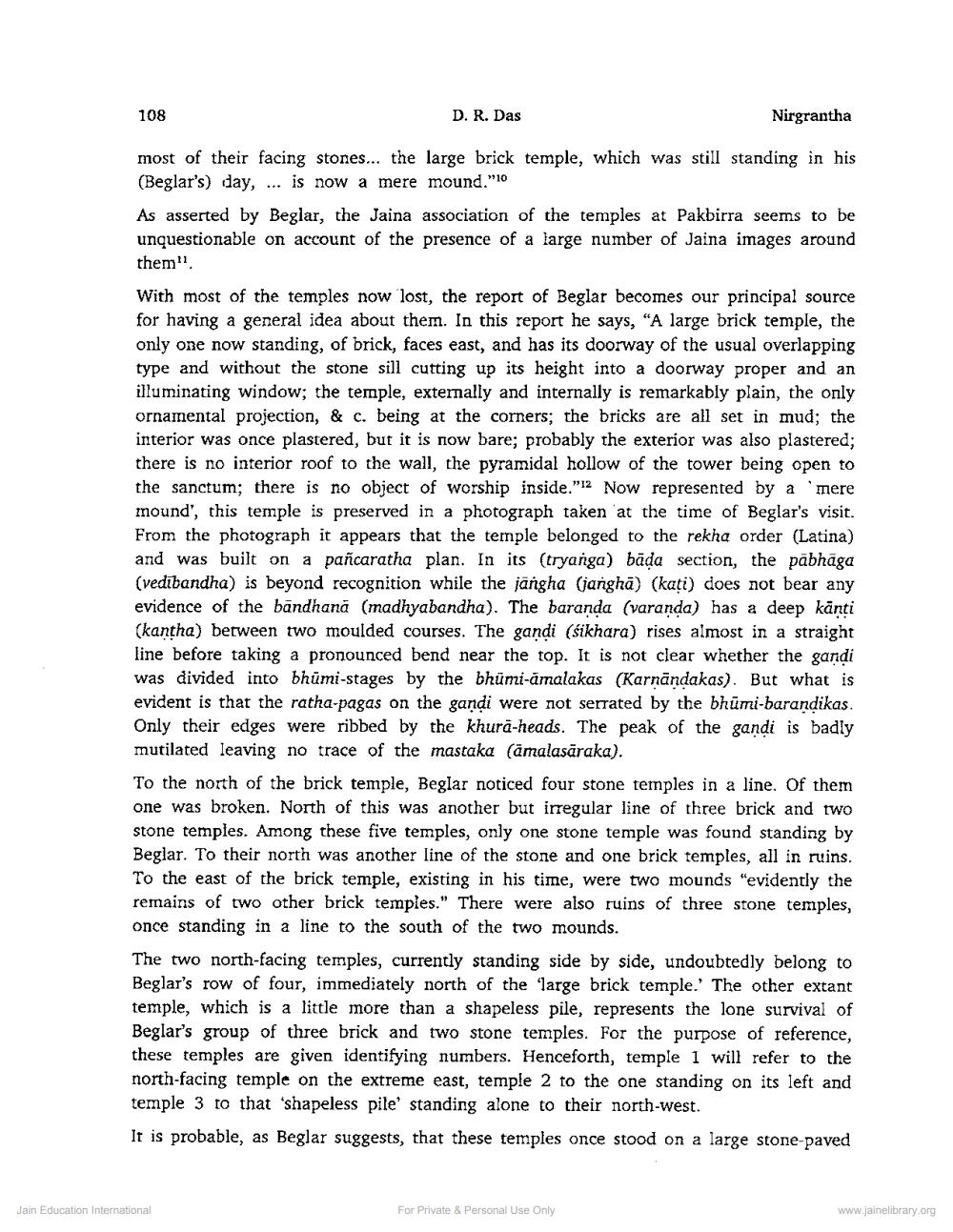Book Title: Jaina Temples of West Bengal Author(s): D R Das Publisher: Z_Nirgrantha_1_022701.pdf and Nirgrantha_2_022702.pdf and Nirgrantha_3_022703.pdf View full book textPage 2
________________ 108 D. R. Das Nirgrantha most of their facing stones... the large brick temple, which was still standing in his (Beglar's) day, ... is now a mere mound."0 As asserted by Beglar, the Jaina association of the temples at Pakbirra seems to be unquestionable on account of the presence of a large number of Jaina images around them! With most of the temples now lost, the report of Beglar becomes our principal source for having a general idea about them. In this report he says, "A large brick temple, the only one now standing, of brick, faces east, and has its doorway of the usual overlapping type and without the stone sill cutting up its height into a doorway proper and an illuminating window; the temple, externally and internally is remarkably plain, the only ornamental projection, & c. being at the corners; the bricks are all set in mud; the interior was once plastered, but it is now bare; probably the exterior was also plastered; there is no interior roof to the wall, the pyramidal hollow of the tower being open to the sanctum; there is no object of worship inside."2 Now represented by a 'mere mound', this temple is preserved in a photograph taken at the time of Beglar's visit. From the photograph it appears that the temple belonged to the rekha order (Latina) and was built on a pañcaratha plan. In its (tryanga) bāda section, the pābhāga (vedibandha) is beyond recognition while the jangha (anghā (kati) does not bear any evidence of the bandhana (madhyabandha). The baranda (varanda) has a deep känti (kantha) between two moulded courses. The gandi (śikhara) rises almost in a straight line before taking a pronounced bend near the top. It is not clear whether the gandi was divided into bhūmi-stages by the bhūmi-amalakas (Karnāndakas). But what is evident is that the ratha-pagas on the gandi were not serrated by the bhūmi-barandikas. Only their edges were ribbed by the khurā-heads. The peak of the gandi is badly mutilated leaving no trace of the mastaka (amalasāraka). To the north of the brick temple, Beglar noticed four stone temples in a line. Of them one was broken. North of this was another but irregular line of three brick and two stone temples. Among these five temples, only one stone temple was found standing by Beglar. To their north was another line of the stone and one brick temples, all in ruins. To the east of the brick temple, existing in his time, were two mounds "evidently the remains of two other brick temples." There were also ruins of three stone temples, once standing in a line to the south of the two mounds. The two north-facing temples, currently standing side by side, undoubtedly belong to Beglar's row of four, immediately north of the large brick temple. The other extant temple, which is a little more than a shapeless pile, represents the lone survival of Beglar's group of three brick and two stone temples. For the purpose of reference, these temples are given identifying numbers. Henceforth, temple I will refer to the north-facing temple on the extreme east, temple 2 to the one standing on its left and temple 3 to that 'shapeless pile' standing alone to their north-west. It is probable, as Beglar suggests, that these temples once stood on a large stone-paved Jain Education International For Private & Personal Use Only www.jainelibrary.orgPage Navigation
1 2 3 4 5 6 7 8 9 10 11 12 13 14 15 16 17 18 19 20 21 22 ... 31
